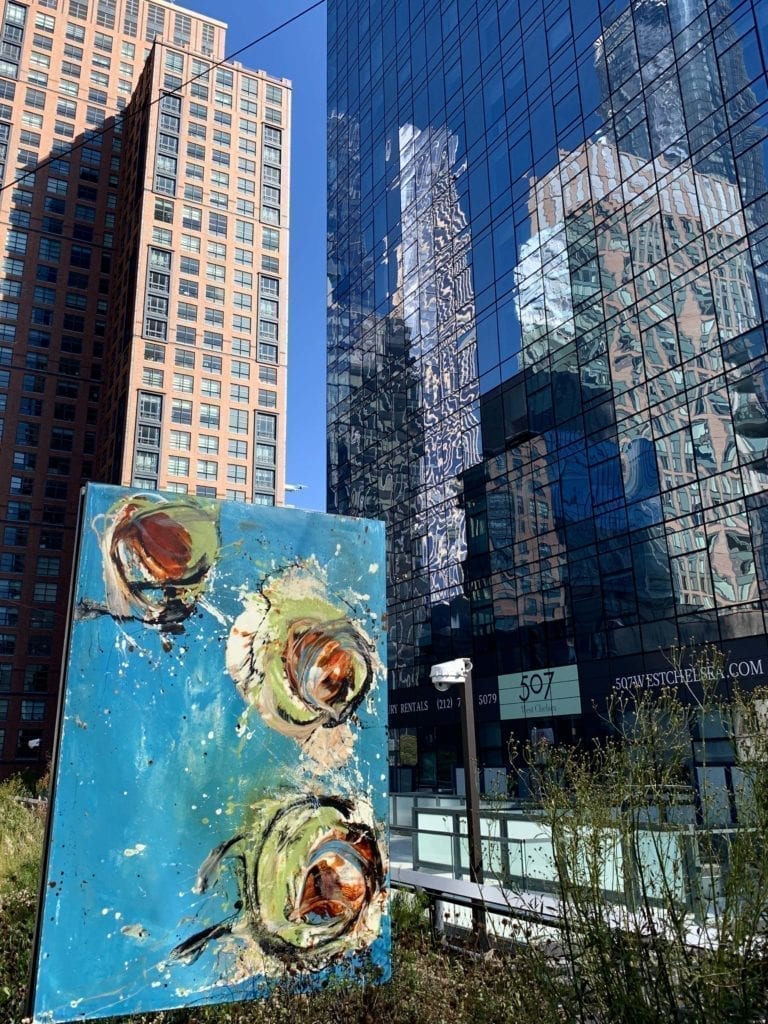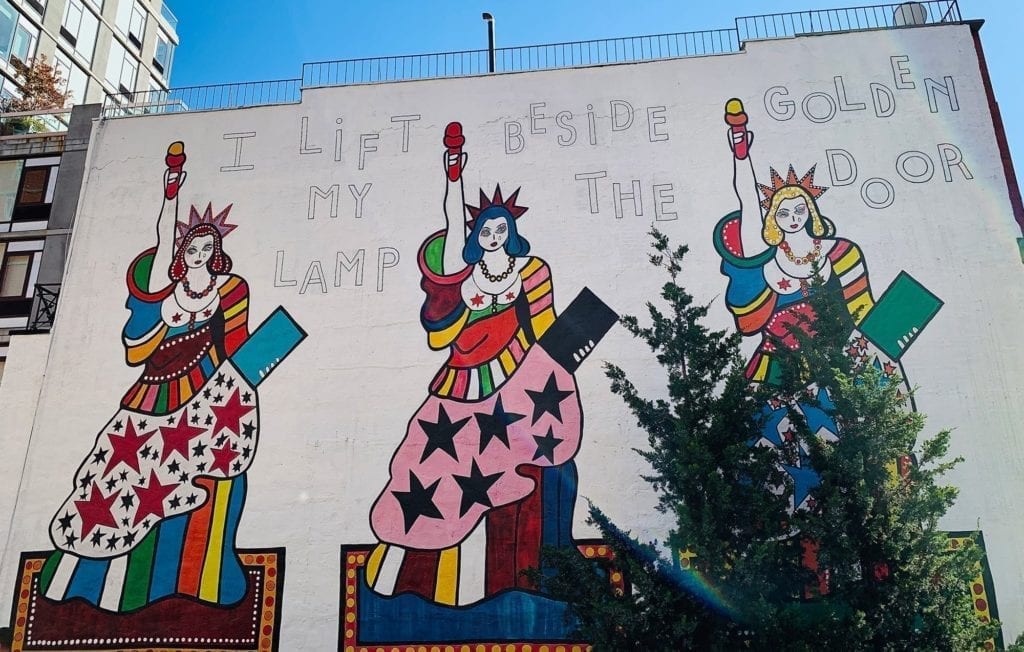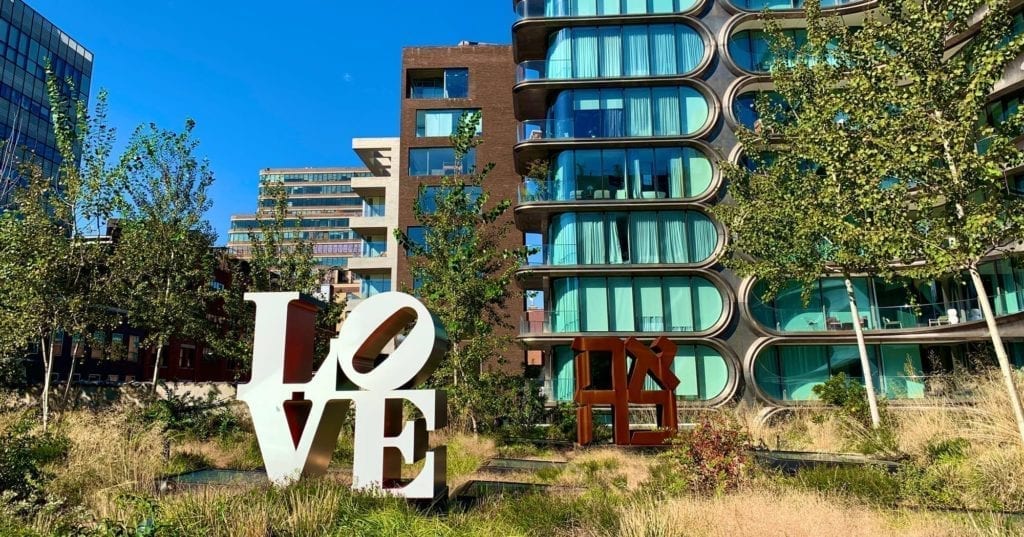High Line History
The New York City High Line started out in 1929 for elevated cargo transport and delivery. Frequent traffic jams had created a real need for it. But The High Line only served this crucial purpose for fifty years. The last train ran this railroad in 1980. In its early days real estate skyrocketed in value around The High Line. That’s because trains could drop freight straight into your building’s second floor. This meant a lot less work for companies like Nabisco, who owned several in the hood. It also minimized street congestion. Trucks weren’t blocking traffic for loading and unloading cargo any more. It was all happening out of the way of New Yorkers.
Click below for the podcast version of this piece.
Now The High Line NYC hood means primo rents for a different reason. It’s sought after as an outdoor artwalk. Celebrated artists clamor for spots in this splendorous garden gallery. It’s the coolest outdoor date in Manhattan. Chic restaurants await at street level. Plants transport visitors out of the city below and into a landscaped wonderland. But art elevates the whole experience. No two High Line visits are the same due to artwork rotation. There’s a range of formats with paintings, sculptures, and even video. You never know what you might see around the next corner. It’s always an enthralling and new surprise. That’s fun and for certain.
Where Does The High Line Start?
If you’re speaking literally, the answer is Gansevoort Street. That’s easier to find than it sounds. Just visit Chelsea Market then turn the corner to 10th avenue and 16th street. Climb up the steel stairs. You’re there. But to answer where our current version of The High Line starts… that’s more complex.
A group called Friends of The High Line kicked off its modern day persona with a contest. The first was a competition of Ideas in 2003. Then a Design battle followed in 2005 to refine the plans. At last, construction began on the artwalk in 2006. Three types of designers united in the process. James Corner Field Operations handled landscaping. Diller Scofidio & Renfro were the architects. While Piet Oudolf managed horticulture. In combination, these teams created a whole new world to wander just above NYC.

Their thoughtful materials and design make it a walk worthy of reminiscence. Every bit of wood in Section Two of The High Line is tropical teak hardwood. This came from demolished Southeast Asian buildings. Its age and wear bring a palpable warmth to this section of the walk. Plants and water features bring The Great Outdoors into the steel girded city. They awaken our five senses to nature. It happens bit by bit. We hear trickles of a nearby brook. Leafy branches brush our cheeks as we pass. These are gentle reminders that we’re part of a natural world too.
Still, the city remains and High Line designers remain humbled to these surroundings. Skyscrapers encircle the walkway at every turn. The streets hum and whiz below. In the evening the pathway’s illuminated at waist level and below. That’s so the night sky and city views stay visible in pictures. Have you ever tried to take a photo next to a streetlamp? Epic fail alert. These modern day details keep The High Line relevant and topical.
Art of The High Line

Walking The High Line feels exceptional no matter when you visit. Outdoor modern art creates an unexpected setting for every type of art. Special sites like the Plinth spotlight extraordinary pieces. The Plinth sits on the Spur. It’s the newest section of The High Line at 30th Street and 10th Avenue. Thanks to this, cars and pedestrians pass sites such as Brick House by Simone Leigh. It’s one way The High Line shares wonder with the active city below.
NYC dwellers see paintings all around on walls, bricks, and steel as a matter of everyday life. It’s no biggie. But wall murals spark more meaning on The High Line. Take the beauty above. A Lady Liberty trio poses proud in star pasties and rainbow frocks. Artist, Dorothy Iannone infuses patriotic majesty into white brick with these bright brushstrokes. The piece declares, I Lift My Lamp Beside the Golden Door. It speaks of America the Beautiful – the concept of a place where opportunity opens arms to all. These are the final words engraved on the Statue of Liberty’s bronze plaque.
Iannone paints fresh nuance into this poem with her vibrant trio. There’s exuberance to these women. They hold hope high with their torches – symbols of bright potential. Wall art in everyday NYC life’s the practice of youth. But, born in 1933, Iannone was in her eighties when she did this piece. She’s got a message about the young, though. This artwork reminds us where hope for the future lives.

Firelei-Báez on The High Line
Spontaneity’s the coolest aspect of wandering The High Line. For instance, during my visit I stumbled upon Firelei-Báez’s work. It was unclear at a glance if this was art or original to the space. The arch appears beaten with age – antiquity even. But the blue works with the sky. This channels the largess of nature into a specific art piece. The scene creates curiosity mixed with awe.
It works well for En Plein Air – this outdoor collection’s name. That’s because Báez portrays a sinking Haitian Ruin here. It’s the Sans Souci Palace built by Frederick the Great. The aged arch represents Haiti’s complex political turmoil. This outward beauty housed revolution, assassination, and an ongoing scramble for control.
Báez’s structure here maintains the artistry of the original palace. In fact, time’s toil renders it all the more alluring. The wear and tear tell stories for the people now long gone. We call them ruins. But age doesn’t ruin us. Rather it makes us stronger. Time gives antiquities like this profound meaning as well.
What Exactly IS The High Line?
Like many New Yorkers, it’s got a patchwork identity. Part public artspace and non-profit, The High Line’s also a landscaped park and walkway. It’s the site of old school railroad tracks. At certain points on the boardwalk visitors encounter them in the landscaping. This lends a rustic feel to the otherwise polished space.
It’s the best date in New York City. Built-in conversation starters abound. Freshly-minted art pieces round every corner. Exquisite views await above all railinsg for your full 360 degree twirl. Careful when you take pictures, though. There’s a magnetic nexus in the lower end of The High Line between West 12th and 20th streets. Because of this, photos taken with digital cameras and smartphones often appear blurry. So, save selfies and portraits for above 21st street.
The city sets a wistful romantic scene from up on The High Line. That bit of distance makes all the difference. At about one and half miles long, it’s the perfect length. That walk takes about a half hour at leisure. It’s enough time to figure out if you want to get a bite or bid adieu. Best part is that if you’re into each other, the Chelsea Market area’s packed with fun eateries.
